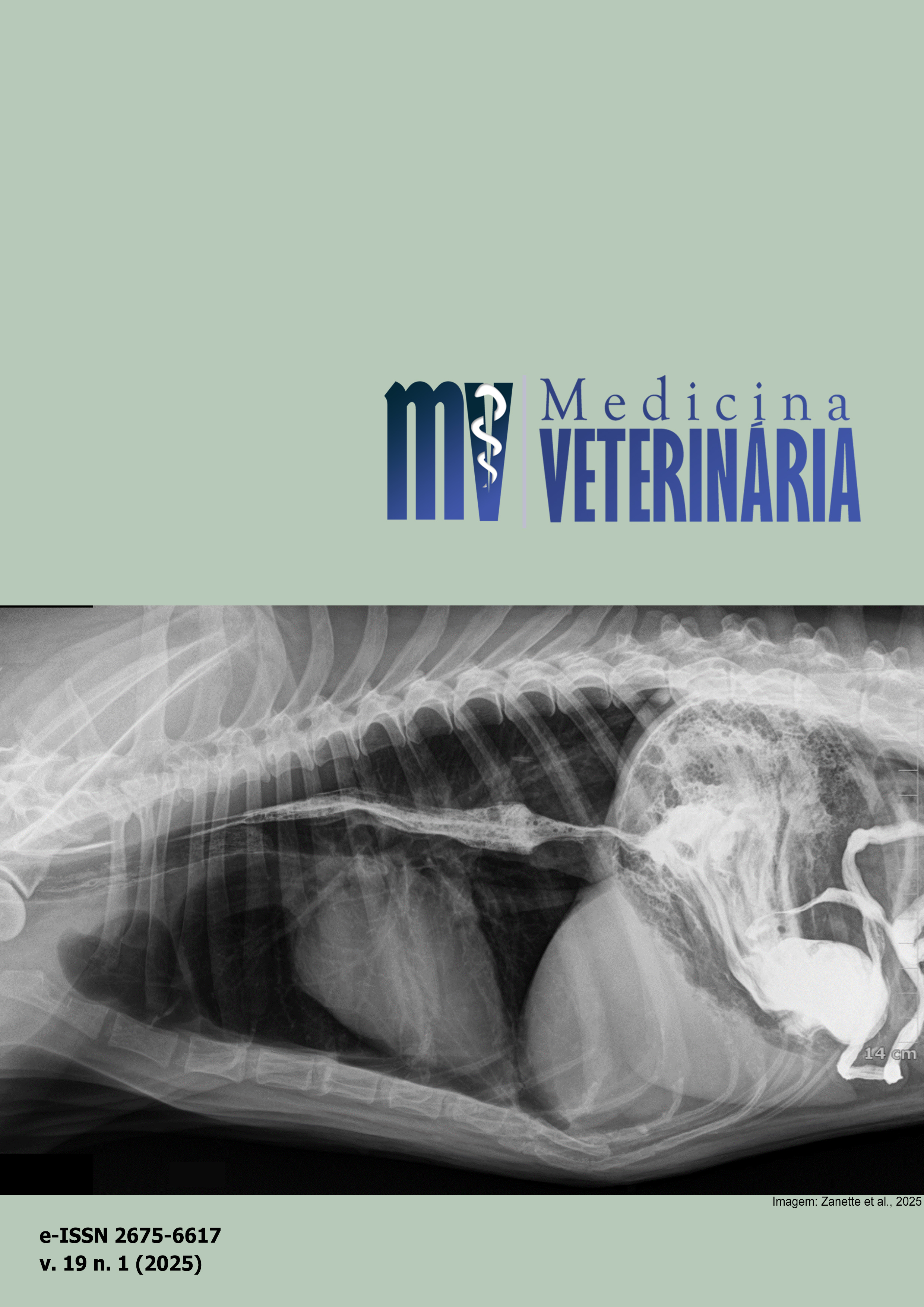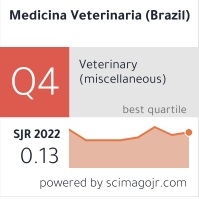Epidemiological and geospatial profile of wildlife illegal trade in the state of Alagoas, northeastern Brazil
DOI:
https://doi.org/10.26605/medvet-v19n1-6951Keywords:
wildlife rescue center, wildlife trafficking, geoprocessingAbstract
The objective of this study was to determine the epidemiological and geospatial profile of mammals, birds, and reptiles rescued from trafficking or illegal situations in the state of Alagoas. A retrospective study was conducted using data from the occurrence registry system of the Alagoas Wildlife Screening Center. For the epidemiological profile of registered wildlife species, the type of occurrence, the destination of animals after rehabilitation, and the degree of extinction risk were considered. QGIS 3.24.3 software was used to carry out the geoprocessing step. During the analyzed period, 3,278 wild mammals were rescued, with Bradypus variegatus being the most notable. Regarding the origin of the animals, 50.43% (1,653) of cases were rescues, and regarding the destination of the animals, 43.44% (1,424) of situations ended in release. Nine species were classified as having worrying degrees of extinction. As for wild birds, 12,056 animals were received, with Sporophila nigricollis being the most notable. Regarding the origin of the animals, 43.65% (5,263) of cases were rescues, and regarding the destination of the animals, 47.68% (5,748) resulted in release. Only Amazona aestiva was classified as near threatened During the analyzed period, 1,494 wild reptiles were rescued, with Chelonoidis carbonaria being the most notable. Regarding the origin of the animals, 35.54% (531) of cases were rescues, and regarding the destination of the animals, 79.12% (1,182) ended in release. Only Chelonia mydas and Chelonoidis carbonaria were classified as vulnerable. Geoprocessing highlighted the importance of BR-101 highway for illegal animal trafficking activities. The data indicate that wildlife trafficking in Alagoas creates conditions for the emergence and spread of zoonoses. The role of federal highways in wildlife trafficking is evident, necessitating the expansion of enforcement actions in critical regions, coupled with popular education.Downloads
References
Alves, R.R.N. et al. Bird-keeping in the Caatinga, NE Brazil. Human Ecology, 38: 147–156, 2010.
Andrighetto, A.; Kraemer, T. Combate ao tráfico de animais silvestres do Brasil: análise da gestão ambiental brasileira. Revista da Defensoria Pública da União, 19: 167-196, 2023.
Avelar, E.R.; Silva, R.; Baptista, L.A.M.L. Ameaças à sobrevivência de animais silvestres no estado de Goiás. Uniciências, 19(2): 132-140, 2015.
Bezerra, D.M.M. et al. Birds and people in semiarid northeastern Brazil: symbolic and medicinal relationships. Journal of Ethnobiology and Ethnomedicine, 9: 3, 2013.
Boseret, G. et al. Zoonoses in pet birds: Review and perspectives. Veterinary Research, 44(1): 36, 2013.
Brookes, V.J. et al. A scoping review of live wildlife trade in markets worldwide. Science of the Total Environment, 1(819): 153043, 2022.
Burgel, C.F.; Machado, V.G. O valor da biodiversidade e a necessidade de conservação: considerações sobre a diversidade biológica brasileira e sua proteção jurídica. In: Scur, L.; Gimenez, J.R.; Burgel, C.F. Biodiversidade, recursos hídricos e direito ambiental. Caxias do Sul: Educs, 2020. p.90-111.
Charity, S.; Ferreira, J.M. Wildlife trafficking in Brazil. Cambridge: TRAFFIC International, 2020. 140p.
Cleaveland, S.; Laurenson, M.K.; Taylor, L.H. Diseases of humans and their domestic mammals: pathogen characteristics, host range and the risk of emergence. Philosophical Transactions of the Royal Society of London. Series B, Biological Sciences, 356:991-999, 2001.
Fonseca, E.; Both, C.; Cechin, S.Z. Introduction pathways and socio-economic variables drive the distribution of alien amphibians and reptiles in a megadiverse country. Diversity and Distributions, 25:1130–1141, 2019.
Fornazari, F.; Teixeira, C. Salmonelose em répteis: aspectos epidemiológicos, clínicos e zoonóticos. Veterinária e Zootecnia, 11:19-25, 2009.
Fornazari, F.; Langoni H. Principais zoonoses em mamíferos selvagens. Veterinária e Zootecnia, 21: 10–24, 2014.
Lawson, K.; Vines, A. Global impacts of the illegal wildlife trade: the costs of crime, insecurity and institutional erosion. Londres: Chatham House, 2014. 50p.
Lopes, A.C.P.A. et al. Tráfico de fauna em Alagoas: guia de identificação das espécies mais comuns em ações de fiscalização e resgate no estado. Maceió: Instituto do Meio Ambiente do Estado de Alagoas, 2017. 136p.
Marshal, B.M.; Strine, C.; Hughes, A.C. Thousands of reptile species threatened by under-regulated global trade. Nature Communications, 11(1): 4738, 2020.
Morcatty et al. Online trade in wildlife and the lack of response to COVID-19 Environmental Research, 193: 110439, 2021.
Pagano, I.S.A. et al. Aves depositadas no Centro de Triagem de Animais Silvestres do IBAMA na Paraíba: uma amostra do tráfico de aves silvestres no estado. Ornithologia, 3(2): 32-144, 2009.
Paré, J.A. et al. Microbiology: fungal and bacterial diseases of reptiles. In: Divers, S.J.; Mader, D.R. Reptile medicine and surgery. Missouri: Elsevier Saunders, 2005. p.217-238.
Phelps, K. et al. Correlates of cave-roosting bat diversity as an effective tool to identify priority caves. Biological Conservation, 201:201-209, 2016.
Prince, T. et al. SARS-CoV-2 Infections in Animals: Reservoirs for Reverse Zoonosis and Models for Study. Viruses, 13(3): 494, 2021.
Rocha, F.M. Tráfico de animais silvestres. Documento para discussão. World Wildlife Fund: WWF - Endangered Species Conservation, 1995. 48p.
Santos, M.C. et al. Quantitative study of wild animals received at WildAnimals Triage Centers (CETAS) in Bahia and identification of trafficking routes. Pesquisa Veterinária Brasileira 41: e06942, 2021.
Taylor, L.H.; Latham, S.M.; Woolhouse, M.E. Risk factors for human disease emergence. Philosophical Transactions of the Royal Society of London. Series B, Biological Sciences, 356: 983-989, 2001.
Downloads
Published
How to Cite
Issue
Section
License
Copyright (c) 2025 Valdir Vieira da Silva, Larissa Luciano de Oliveira Ferro, Laís Caroline Gomes Ramos, Ana Cecília Pires de Azevedo Lopes, Epitácio Correia de Farias Júnior, Jonatas Campos de Almeida

This work is licensed under a Creative Commons Attribution-NonCommercial-ShareAlike 4.0 International License.
A Revista de Medicina Veterinária permite que o autor retenha os direitos de publicação sem restrições, utilizando para tal a licença Creative Commons CC BY-NC-SA 4.0.
De acordo com os termos seguintes:
Atribuição — Você deve dar o crédito apropriado, prover um link para a licença e indicar se mudanças foram feitas. Você deve fazê-lo em qualquer circunstância razoável, mas de nenhuma maneira que sugira que o licenciante apoia você ou o seu uso.
NãoComercial — Você não pode usar o material para fins comerciais.
CompartilhaIgual — Se você remixar, transformar, ou criar a partir do material, tem de distribuir as suas contribuições sob a mesma licença que o original.
Sem restrições adicionais — Você não pode aplicar termos jurídicos ou medidas de caráter tecnológico que restrinjam legalmente outros de fazerem algo que a licença permita.







